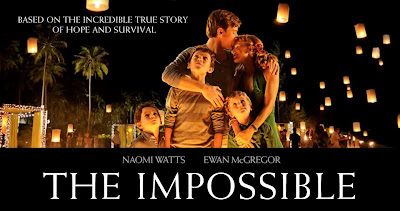A Force of Nature inside a Force of Cinema
Clint Eastwood's 2010 Hereafter opened with a scene depicting the devastating 2004 tsunami that struck Asia, killing hundreds of thousands of people throughout over a dozen countries. Juan Bayona's The Impossible recreates that same event, with much better special effects, but rather than using it as a segway into another story, focuses only on that event, as well as (primarily) the aftermath. Rather than taking on the truly impossible task of telling the story of the many survivors, The Impossible hones in on a single family, using them as a microcosm of the entire event. Can we imagine that their struggles resemble that of so many of the others? Most certainly. Except some people weren't as lucky to have survived.
I cannot imagine anything more terrifying than watching a wall of water, moving with unstoppable force, bear down upon you, destroying everything in its path and sweeping you up in a mire of chaos, debris, and of course, lots of water. Most of the first act of The Impossible depicts this, in a completely believable portrait. Based, however loosely, on the true story of a western family vacationing in Thailand, the film shows their struggles as these two parents and three children are swept away from their beach-side hotel by the ocean. They are separated; the mother and eldest son carried to one location, the father and remaining two sons in another. The father is Henry (Ewan McGregor). The mother is Marie (Naomi Watts). The eldest son is Lucas (Tom Holland, who quickly earns his place among the great breakout performances of 2012). After the tsunami strikes, we see Marie and Lucas being carried away by the water. They desperately try to cling to each other as they move swiftly through the water, along with cars, trees, and pretty much anything else that was in the path of this storm.
Marie is injured badly in the tsunami, but she bravely clings to life as she and Lucas make their way to drier land among other survivors. Eventually, they find themselves in a hospital, as Marie desperately needs medical attention. It is here where the 12 year-old Lucas shows his strength of character. When they hear a young boy yelling for help, Marie wants to find him. Lucas urges her that they get up into a nearby tree before another wave strikes; they can't help everyone. Ultimately, they do help the little boy, which later results in one of the film's more touching scenes.
The scenes after the tsunami depict the harrowing truth of disastrous acts of God, both the good and the bad. Hundreds of thousands are dead, even more are injured. Part of the beauty of this film is the way in which (most) everybody comes together to help each other. Not many people have cell phones, and if they do, they want to preserve their battery. When Henry, who is searching for his wife and son, sits with a group of survivors, one of them offers him his phone to call back home. This man, who has lost hope in finding his own family, accompanies Henry as he searches hospitals and groups of survivors for the rest of his family. When Lucas and Marie are in the hospital, Lucas sets out to help survivors reconnect with their separated loved ones. It seems a futile effort in all this chaos, but Lucas is undeterred; brave and strong-willed, he shows a resourcefulness and strength that few adults possess. He also exhibits a sense of reality that Marie buries under denial; it is true that they cannot help everyone, but she cares not - "what if that boy was you?" she asks him. "What if it was Thomas?" Lucas immediately and directly tells her that Thomas, Simon, and his father are dead. His mind isn't plagued by that idea; his attention is on getting his mother and himself to safety, he can mourn their deaths later. It almost seems as though Lucas was born for a situation such as this. Of course, however, his father and brothers are not dead, but it is an honest reality to assume that they are.
The acting on display is phenomenal. Ewan McGregor as the determined father shows a vulnerability that we haven't often seen from him. Naomi Watts once again proves why she is one of the finest working actresses in the business. And Tom Holland turns in, alongside Quevenzhane Wallis (Beasts of the Southern Wild), one of the greatest child performances of the year. Like Wallis in that film, he is strong-willed and immovable in character.
Director Juan Bayona and screenwriter Sergio Sanchez, who previously collaborated on the wonderful The Orphanage, flex their story-telling muscles with great success once again. What could have been a droll, manipulative melodrama becomes something much greater in their hands; it successfully realizes its vision by not undermining the lives of the thousands of unseen victims in pursuit of a touching story about love, life, and hope. Not for a second do we forget that so many families had it much worse than this one. The film's most touching moments are never overplayed; they never embellish in emotion, but simply allow it to exist. The result is one of the most heartfelt films of 2012.




No comments:
Post a Comment